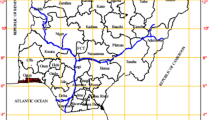Abstract
The lack of adequate water supply and sanitation services is a major issue related to sustainable development in many parts of the developing world. New strategic planning approaches which directly address users’ needs and demand—often referred to as demand-responsive, community-based or household-centred approaches—are regarded as a crucial step towards improving the situation. This paper investigates household needs and demand for improved water supply and sanitation services in peri-urban, low-income settlements, known as “ger areas”, in the city of Darkhan, Mongolia. The paper is based largely on a household survey conducted in a selected ger area subdistrict in Darkhan. The results reveal a complex picture. Even if the existing situation can be regarded as largely “improved” in terms of the definitions stipulated by the Joint Monitoring Programme for water supply and sanitation, it is shown that there is a need for action nonetheless. The paper also argues that the household survey is a useful method for assessing users’ needs and demand and for meeting the requirements of demand-responsive sanitation planning approaches.
Similar content being viewed by others
Notes
The general institutional framework conditions for dealing with water related problems are discussed in Horlemann and Dombrowsky (2011).
This is the meaning intended in this paper by the phrase “the households surveyed”.
The JMP is the United Nations programme tasked with monitoring progress towards the Millennium Development Goal 7, target 7c. The achievement of the MDG is measured by indicators using an improved/unimproved dichotomy.
Interview statement May 2009.
Multiple answers possible.
Blackwater is the mixture of urine, faeces and dry cleansing material, e.g. toilet paper.
Multiple answers possible.
According to the local service provider USAG, water consumption in the study area has increased fivefold since the nine water kiosks were connected to the central grid (interview statement September 2010).
Greywater accounts for half of the total organic load and for up to two-thirds of the phosphorous load in domestic wastewater (Morel and Diener 2006).
References
Basandorj D, Altanzagas B (2007) Current situation and key problems on water supply and sanitation in Mongolia. IFOST 2007. Strategic technology. International forum, Ulaanbaatar, Mongolia
City of Ulaanbaatar (2006) Hygiene and sanitation situation report for ger areas, Mongolia: Community-led infrastructure development project. Prepared with financial support of the World Bank-Netherlands Water Partnership, Ulaanbaatar
Darkhan-Uul aimag (2009) Statistical review in Darkhan-Uul aimag
Eawag (2005) Household-centred environmental sanitation: provisional guideline for decision-makers. Dübendorf, Switzerland
Hofmann J, Scharaw B (2008) Bericht im Rahmen des MoMo-Projekts: Versorgungssituation der ländlichen Bevölkerung mit Trinkwasser und Entsorgung des Abwassers sowie Einschätzung der Gewässerbelastung mit Schwermetallen. Ergebnisse der Geländekampagne vom 05.-08.09.2008
Horlemann L, Dombrowsky I (2011) Institutionalising IWRM in developing and transition countries—the case of Mongolia. Environ Earth Sci. doi:10.1007/s12665-011-1213-7 (this issue)
Kalbus E et al (2011) Foreword to the SI on integrated water resouces management under different hydrological, climatic and socio-economic conditions. Environ Earth Sci. doi:10.1007/s12665-011-1330-3 (this issue)
Kvarnström E, McConville J (2007) Sanitation planning—a tool to achieve sustainable sanitation? In: Proceedings of the international symposium on water supply and sanitation for all. Huber, Berching, 27–28 Sept 2007
Lüthi C, Morel A and Tilley E (2008) Integrate at the top, involve at the bottom—the household-centred approach to environmental sanitation. IRC symposium: sanitation for the urban poor, partnerships and governance
Lüthi C, McConville J, Kvarnström E (2009) Community-based approaches for addressing the urban sanitation challenges. Int J Urban Sustain Dev 1:49–63
Mara D, Alabaster G (2008) A new paradigm for low-cost urban water supplies and sanitation in developing countries. Water Policy 10:119–129
MoMo (2009) Integrated water resources management for central asia: model region mongolia (MoMo). Case study in the Kharaa River Basin. Final project report. Sept 2009
Morel A, Diener S (2006) Greywater management in low and middle-income countries, review of different treatment systems for households or neighbourhoods. Dübendorf, Switzerland
NDIC (2009) The millennium development goals implementation. Third national report, Ulaanbaatar
PADCO (2005) Mongolia city development. Strategies for secondary cities. Final report. prepared for world bank
Schertenleib R (2005) From conventional to advanced environmental sanitation. Water Sci Technol 51:7–14
Sigel K (2010) Environmental sanitation in peri-urban ger areas in Darkhan (Mongolia): a description of current status, practices, and perceptions. UFZ-Bericht 02/2010, Leipzig
SuSan A (2008) Planning for sustainable sanitation in cities. Factsheet sustainable sanitation alliance, version 1.1
UNDP (2003) Human development report Mongolia. Urban–rural disparities in Mongolia, Ulaanbaatar
UNDP (2010) Country sector assessments. UNDP GoAL WaSH programme. governance, advocacy and leadership for water, sanitation and hygiene. volume 2, new york
UNDP and UNICEF (2004) Access to water and sanitation services in Mongolia, Ulaanbaatar
UNICEF (2003) The living conditions of the children in peri-urban areas of Ulaanbaatar. summary report
UNICEF and UNDP (2008) Improving local service delivery for the millennium development goals. Restoring the image of blue Mongolia: rural water supply and sanitation, Ulaanbaatar
UNICEF and WHO (2008) Progress on drinking water and sanitation. Special focus on sanitation. Joint monitoring programme for water supply and sanitation, Geneva
WHO and UNICEF (2006) Core questions on drinking-water and sanitation for household surveys, Geneva
World Bank (2010) Mongolia. Enhancing policies and practices for ger area development in Ulaanbaatar. Conference version, Washington DC
Acknowledgments
This work was supported by funding from the Federal Ministry for Education and Research (BMBF) in the framework of the project “IWAS—International Water Research Alliance Saxony” (Grant 02WM1027). Thanks are due to the assistants and interviewees involved in the household survey, and to various colleagues, especially Johannes Schiller, for their helpful advice and comments. Special thanks go to three anonymous referees for very useful comments which helped to significantly improve this article.
Author information
Authors and Affiliations
Corresponding author
Rights and permissions
About this article
Cite this article
Sigel, K., Altantuul, K. & Basandorj, D. Household needs and demand for improved water supply and sanitation in peri-urban ger areas: the case of Darkhan, Mongolia. Environ Earth Sci 65, 1561–1566 (2012). https://doi.org/10.1007/s12665-011-1221-7
Received:
Accepted:
Published:
Issue Date:
DOI: https://doi.org/10.1007/s12665-011-1221-7




